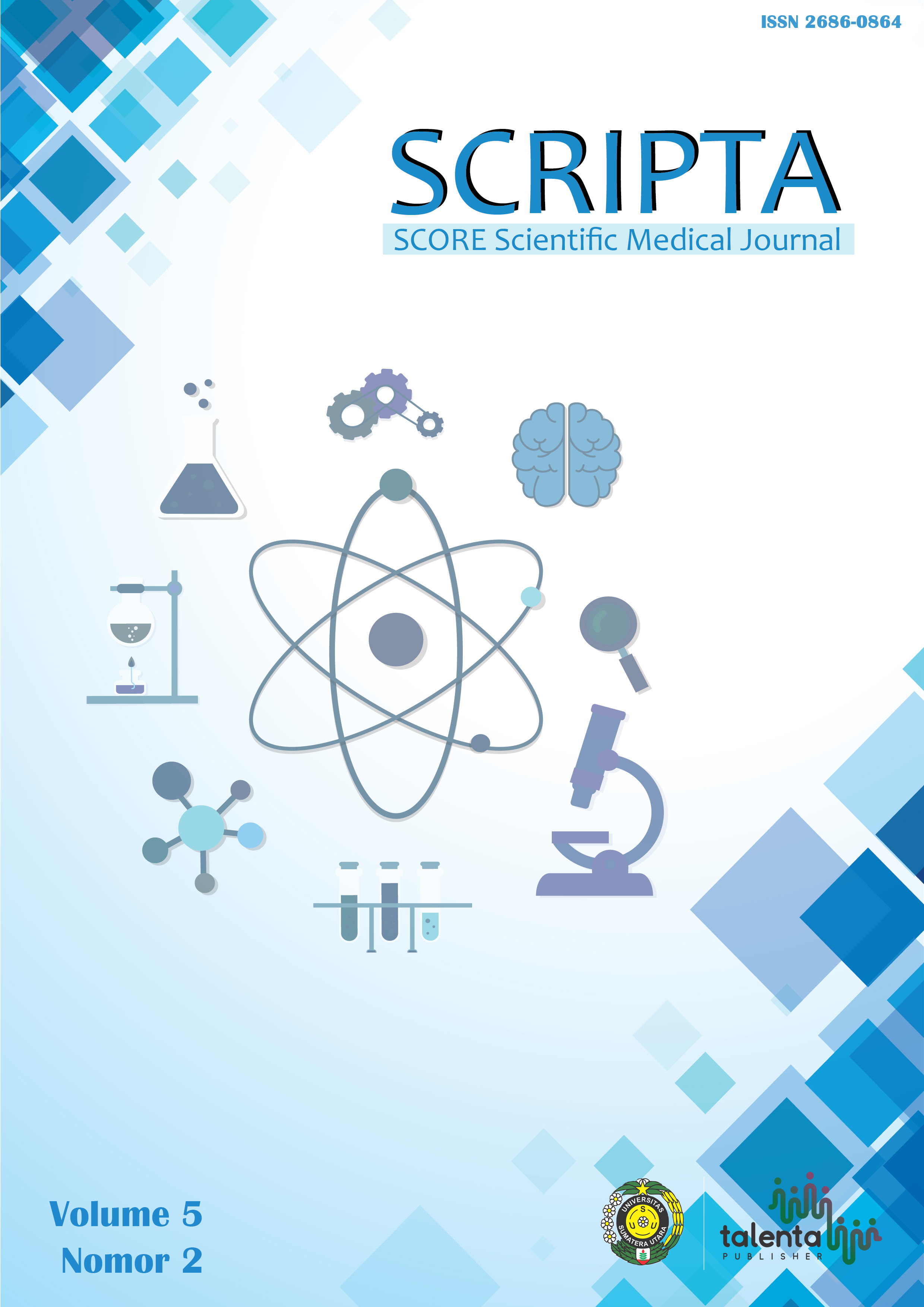Effectiveness and Safety of Bovine Human Pentavalent Rotavirus Vaccine (BRV-PV) in Preventing Severe Acute Rotavirus Gastroenteritis (SRVGE): A systematic review of the experience in developing countries
DOI:
https://doi.org/10.32734/scripta.v5i2.15201Keywords:
BRV-PV, gastroenteritis, rotavirus, rotavirus vaccineAbstract
Background: Severe acute rotavirus gastroenteritis (SRVGE) is the world's highest cause of children mortality, with symptoms of severe dehydrating diarrhea due to rotavirus (RV) infection. SRVGE provides a high economic burden, mostly in developing countries. Currently, three RV vaccines (Rotarix, RotaTeq, Rotavac) are licensed internationally by the World Health Organization (WHO) and are not yet applicable in developing countries. Hence, research shows the potential of BRV-PV in preventing RV infection in pediatrics, especially in developing countries. Objective: This review aims to analyze the effectiveness and safety of BRV-PV in developing countries. Methods: This systematic review includes studies from the ScienceDirect, PubMed, Elsevier, and Cochrane databases that met the inclusion and exclusion criteria. The search method uses the Boolean operator with the articles from the last ten years. Eight articles with a total of 9088 children were reviewed to analyze the effectiveness and safety of BRV-PV. Results and Discussion: Of all the studies involved, BRV-PV has effectively reduced the incidence of hospitalization and emergency cases due to SRVGE. Furthermore, BRV-PV is also safe for children in developing countries, proven by increased anti-RV IgA concentrations and minimal side effects. Conclusion: BRV-PV is more effective, safe, heat-stable, and affordable than the previous three RV vaccines in developing countries
Keyword: BRV-PV, Gastroenteritis, Rotavirus, Rotavirus Vaccine
Latar Belakang: Severe acute rotavirus gastroenteritis (SRVGE) merupakan penyebab kematian anak tertinggi di dunia dengan gejala diare dehidrasi parah akibat infeksi rotavirus (RV). SRVGE memberikan beban ekonomi yang tinggi, terutama di negara-negara berkembang. Saat ini, tiga vaksin RV (Rotarix, RotaTeq, Rotavac) dilisensikan secara internasional oleh World Health Organization (WHO) dan belum dapat diterapkan di negara-negara berkembang. Oleh karena itu, penelitian menunjukkan potensi BRV-PV dalam mencegah infeksi RV pada anak-anak, khususnya di negara berkembang. Tujuan: Ulasan ini bertujuan untuk menganalisis efektivitas dan keamanan BRV-PV dalam mencegah SRVGE. Metode: Tinjauan sistematis ini mencakup studi dari database ScienceDirect, PubMed, Elsevier, dan Cochrane yang memenuhi kriteria inklusi dan eksklusi. Metode pencariannya menggunakan operator boolean dengan artikel sepuluh tahun terakhir. Delapan artikel dengan total 9088 pediatri ditinjau untuk menganalisis efektivitas dan keamanan BRV-PV. Hasil dan Pembahasan: Dari semua penelitian yang terlibat, BRV-PV telah secara efektif mengurangi kejadian rawat inap dan kasus darurat akibat SRVGE. Selain itu, BRV-PV juga aman untuk anak-anak di negara berkembang, terbukti dengan peningkatan konsentrasi IgA anti-RV dan efek samping yang minimal. Kesimpulan: BRV-PV lebih efektif, aman, tahan panas, dan terjangkau dibandingkan tiga vaksin RV sebelumnya di negara berkembang..
Kata Kunci: BRV-PV, Gastroenteritis, Rotavirus, Vaksin Rotavirus
Downloads
Downloads
Published
How to Cite
Issue
Section
License
Copyright (c) 2024 Zefianto, Achmad Rifky Ansyori, Sarah

This work is licensed under a Creative Commons Attribution-NonCommercial 4.0 International License.
Authors who publish with SCRIPTA SCORE Scientific Medical Journal agree to the following terms:
- Authors retain copyright and grant SCRIPTA SCORE Scientific Medical Journal right of first publication with the work simultaneously licensed under a Creative Commons Attribution-NonCommercial License that allows others to remix, adapt, build upon the work non-commercially with an acknowledgment of the work’s authorship and initial publication in SCRIPTA SCORE Scientific Medical Journal.
- Authors are permitted to copy and redistribute the journal's published version of the work non-commercially (e.g., post it to an institutional repository or publish it in a book), with an acknowledgment of its initial publication in SCRIPTA SCORE Scientific Medical Journal.














